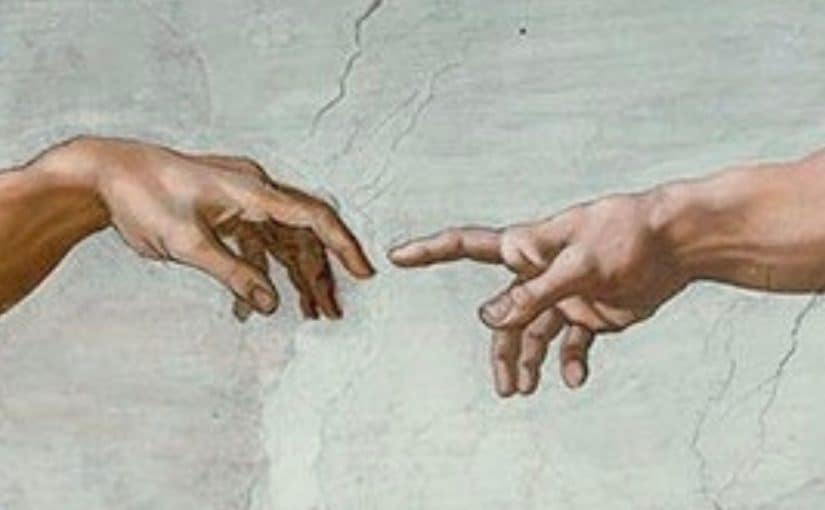— Made in God’s Image, a 10-Part Bible Study Series —
What exactly does being made in God’s image mean? What are some of the practical implications?
An overview of this Bible study series is available here.
An article introducing part 2 is available here.
This is a teaching plan for the second session.
Ask the members of your Bible study group to turn to Genesis 3, and ask a volunteer to read verses 1-13.
Genesis 31 Now the serpent was more cunning than any beast of the field which the LORD God had made. And he said to the woman, “Has God indeed said, ‘You shall not eat of every tree of the garden’?”
2 And the woman said to the serpent, “We may eat the fruit of the trees of the garden; 3 but of the fruit of the tree which is in the midst of the garden, God has said, ‘You shall not eat it, nor shall you touch it, lest you die.’ ”
4 Then the serpent said to the woman, “You will not surely die. 5 For God knows that in the day you eat of it your eyes will be opened, and you will be like God, knowing good and evil.”
6 So when the woman saw that the tree was good for food, that it was pleasant to the eyes, and a tree desirable to make one wise, she took of its fruit and ate. She also gave to her husband with her, and he ate. 7 Then the eyes of both of them were opened, and they knew that they were naked; and they sewed fig leaves together and made themselves coverings.
8 And they heard the sound of the LORD God walking in the garden in the cool of the day, and Adam and his wife hid themselves from the presence of the LORD God among the trees of the garden.
9 Then the LORD God called to Adam and said to him, “Where are you?”
10 So he said, “I heard Your voice in the garden, and I was afraid because I was naked; and I hid myself.”
11 And He said, “Who told you that you were naked? Have you eaten from the tree of which I commanded you that you should not eat?”
12 Then the man said, “The woman whom You gave to be with me, she gave me of the tree, and I ate.”
13 And the LORD God said to the woman, “What is this you have done?”
The woman said, “The serpent deceived me, and I ate.”
Explain that in Genesis 3, we read a record of the fall of humanity, the point at which sin entered the human race and messed everything up. Adam and Eve did die with respect to their relationship with God when they disobeyed Him (note in verse 9 that “the LORD God called to Adam and said to him, ‘Where are you?’”). Also, their disobedience set the stage for their physical deaths, which would occur later. Ask a volunteer to reread verses 4 and 5:
Then the serpent said to the woman, “You will not surely die. For God knows that in the day you eat of it your eyes will be opened, and you will be like God, knowing good and evil.”
Note that in verse 4 the serpent denied God directly. Previously, in verse 2, he asked Eve if God really had said they would die if they disobeyed; so he first questioned God, and then denied Him.
Point out that one of Satan’s tactics is to place doubts in our heads regarding God, and then to build on those by lying about God’s integrity. Ask: What was the “big temptation” Satan dangled in front of Eve? Discuss. It was that if they ate the forbidden fruit, they would “be like God, knowing good and evil” (emphasis added).
Yes, when Eve, and then Adam, ate from the tree in disobedience to God, they did come to know good and evil, but their actions were harmful and destructive in the worst of ways. Write this quote from Dr. Mark Corts, pastor of Calvary Baptist Church in Winston-Salem, North Carolina for nearly 40 years, on the board or screen:
The essence of sin is always trying to be like God without God.

Of course, we don’t know if the forbidden fruit was an apple; nor do we know if it looked like an apple. Even so, we can imagine it as one. The point is that the first man and woman disobeyed God, and they and all of their descendants have experienced severe consequences ever since.
Discuss what is involved in the temptation to be like God apart from God. Ask: How is every temptation a temptation to be like Him apart from Him? Point out that at the root of it all is pride. It was pride that Satan embraced when he defied God, and he was thrown out of heaven for his mutiny and arrogance. Pride is disastrous and even deadly for us well.
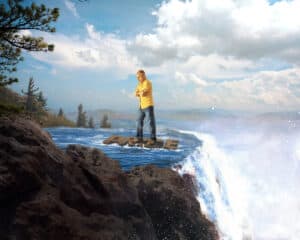
Direct your participants’ attention once more to Dr. Corts’s observation. Explain that there is a way to be like God that is consistent with His purpose and plan. In fact, there was a sense in which God already had made human beings — the man and the woman — like Himself. Say: We read and discussed Genesis 1:26-28 during our first Bible study session; let’s look at them again. In this series of verses, in verse 28, we see what has been called the “cultural commission.”
Genesis 126 Then God said, “Let Us make man in Our image, according to Our likeness; let them have dominion over the fish of the sea, over the birds of the air, and over the cattle, over all the earth and over every creeping thing that creeps on the earth.” 27 So God created man in His own image; in the image of God He created him; male and female He created them. 28 Then God blessed them, and God said to them, “Be fruitful and multiply; fill the earth and subdue it; have dominion over the fish of the sea, over the birds of the air, and over every living thing that moves on the earth.”
Explain: Earlier, we indicated that when sin entered the world, it “messed everything up.” However, it did not eliminate the image of God in man. (In this study, we are using and will use, from time to time, the term man to refer to all human beings, to mankind in general.) Yes, sin left its mark. People do not reflect God’s image as clearly as they would have had sin not entered the picture, but they still bear His image and reflect it in a multitude of ways.
As we noted in the article introducing this Bible study session, authors Charles Colson and Nancy Pearcey emphasize this reality in their book How Now Shall We Live? Here we will express it this way:
Sin marred but did but did not destroy God’s image in man. In fact, the image of God is still quite clearly evident. It’s even self-evident.
More on this last point a bit later.
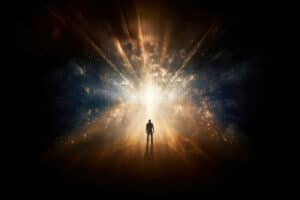
Ask: In what ways had God already (before the fall) made the man and the woman like Himself? We see one clear way in the choice the woman and the man made to disobey God. They were free moral agents, free to make their own choices. We can call this sovereignty; man was and is sovereign, or able to make his own decisions about whether to do right or wrong.
Now, we need to be clear that man’s sovereignty and God’s are not and were not identical. God is sovereign in the absolute sense. And while God made man free like Himself, God is absolutely holy and will never violate His own character. In other words, God is free, but He isn’t free to sin. Man was like God in that he was free, but obviously he was and is free to disobey God and to sin. If he does sin, though, he must face certain consequences.
Ask: Why did God make human beings free to obey or to disobey Him? Had He programmed them to obey without the freedom to disobey, He would not have created them in His image. He would have made them like robots — or like the animals that act only out of instinct — like the birds, bees, and beavers we mentioned in the introductory article.
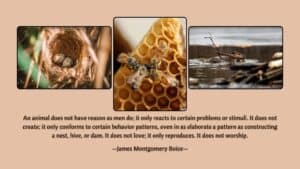
In the same article, we listed seven general categories or ways human beings reflect God’s nature — or we could say “ways human beings are like God, according to God’s design and plan.” People are special and unique in that they 1) create, 2) communicate, 3) contemplate, 4) initiate, 5) relate, 6) administrate and delegate, and 7) appreciate.
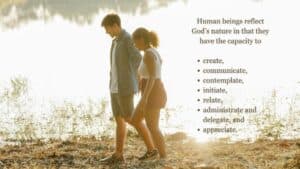
Ask the members of your group what items they might add to this list.
Divide your group into groups of 3 or 4. Distribute a blank sheet of paper and pen to each group. Ask groups to brainstorm together and to list items or characteristics that set human beings apart from the rest of God’s creation. After eight minutes or so, reconvene and ask a volunteer from each group to share the items his or her group listed. See which group was able to make the longest list. Here is a list of thirty-one qualities of human beings that set the human race apart from plants and animals, and that testify to God’s having made people in His image. The list is far from exhaustive, but it is representative. A one-page edition of the list is available here.
Do you see now why we would say that God’s image on man is self-evident? Even so, we have still more to say about this. Hang tight!
Group Investigations
Divide your class into four groups and give each group one of the following assignments.
Group 1: Cousin Reginald Spells Peloponnesus
Art in its many forms, including music and painting, has a way of bringing out in people qualities and traits that set human beings apart from the rest of God’s creation. In other words, art is a vehicle that helps us see what it means to be made in God’s image. This makes an examination of a particular painting especially interesting. You’ll find a PDF copy of the 1918 Norman Rockwell Painting Cousin Reginald Spells Peloponnesus here. The painting is in the public domain.
Reproduce enough copies of the questionnaire below so each member of group 1 can have a copy. The questionnaire has enough material on it to engage the members of group 1 the entire amount of time you give them.
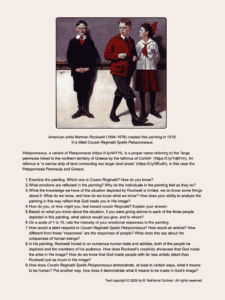
Group 2: Thomas Edison
Ask the members of group 2 to visit https://www.discoverbedrocktruth.org/edison/ or https://t.ly/mbe8j
Ask them to watch the mini biography from Biography and to use the assignment sheet provided (a reproducible PDF is available here) in discussing it.
Group 3: George Washington Carver
Ask the members of group 3 to visit https://www.discoverbedrocktruth.org/carver/ or https://t.ly/SHydz
Ask them to watch video and to use the assignment sheet provided (a reproducible PDF is available here) as they discuss insights they can glean from Carver and his life about what it means to be made in God’s image.
Group 4: Knowing the Shepherd
Ask the members of group 4 to visit https://discoverbedrocktruth.org/psalm-23/ or https://t.ly/yr8Nw — or distribute this handout to each group member.
Ask the members of this group to read the account and use the discussion starters as they share insights about the story. Ask them to come up with several takeaways from their discussion about how human beings are like God because He has made them in His image.
Too Many People?
Ask a volunteer to reread Genesis 1:28:
Then God blessed them, and God said to them, “Be fruitful and multiply; fill the earth and subdue it; have dominion over the fish of the sea, over the birds of the air, and over every living thing that moves on the earth.”
Say: We hear a great deal about overpopulation today, but God’s command to “be fruitful and multiply” and to “fill the earth” has not been retracted. Share this PragerU video to get a refreshing perspective on the population debate.
Discuss briefly the ideas presented in the video. Emphasize how a biblical worldview helps those who espouse it 1) be good stewards of all they have at their disposal, and 2) remain confident, even as they swim against the tide of the often-unbiblical cultural narrative.
Economic Freedom Means Personal Freedom
Remember that earlier, we said that, having been made in God’s image, these qualities characterize human beings:
People are special and unique in that they 1) create, 2) communicate, 3) contemplate, 4) initiate, 5) relate, 6) administrate and delegate, and 7) appreciate.

To fulfill the cultural mandate of Genesis 1:28, which is inseparably linked to having been made in God’s image (see vv. 26-27), people must have a good measure of freedom, and they must have and exercise certain rights, including private property rights. George Washington once said, “Freedom and Property Rights are inseparable. You can’t have one without the other.” Calvin Coolidge, who was President of the United States from August, 1923 to March, 1929, agreed, but he expressed it differently. He said, “Ultimately property rights and personal rights are the same thing.”
The free enterprise system we commonly call capitalism sets the stage for people to reach their fullest potential as they work to fulfill God’s command in Genesis 1:28.
Capitalism has been given bad rap today — but it’s socialism that fosters greed, envy, resentment, and hostility among citizens. Distribute this handout to all your participants and contrast socialism to free enterprise. Point out that the major differences are that
-
- socialism insists on no private property and on central planning, and
- free enterprise rests on the principles of private property rights and individual freedom.
Share this article (handout is available here) with your participants and talk about why socialism is inherently unjust. There’s more! When it isn’t abused, the free market promotes biblical virtues. The solution isn’t to replace the free market with socialism, but to rid it of abuse.

-
-
- productive work (Prov. 12:24)
- rewards for work (Prov. 14:23)
- voluntary transactions and property rights
- integrity (Prov. 13:11)
- trust
-
Allowing free and honest trade and supporting it are among the things government can do to promote freedom and prosperity. In Session 6, we’ll explore government’s main responsibility, according to Scripture.
Looking Ahead
Next time, we’ll examine what authentic freedom and liberty are. Stay tuned!
Copyright © 2024 by B. Nathaniel Sullivan. All rights reserved.
